Venice is a city built on water and stands as a marvel of engineering and architecture. From its iconic gondolas to its vibrant Carnivals, Venice continues to enchant visitors to Italy.
Exploring Venice
To truly experience Venice, immerse yourself in its labyrinth of canals and narrow streets. The city is made up of many islands, each offering its own charm. The main island features iconic landmarks, while Murano is famous for its glassmaking and Burano is known for its lace and colorful houses.
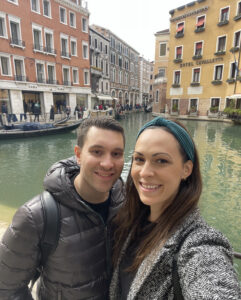
Quick Facts
- No Cars: Venice has no roads; you can only get around by boat or on foot.
- Sinking City: Due to rising sea levels and other factors, Venice sinks about 1-2 millimeters each year.
- Masquerade Origins: Venice is a key origin of masquerade culture, dating back to the Italian Renaissance. Masks allowed nobility to conceal their status and engage in anonymous romantic interactions.
- Flooding Issues: Known as Acqua Alta (High Water), flooding in Venice occurs due to high tides and storm surges, with the worst flooding happening from October to February.
- Declining Population: Venice’s population is decreasing due to high living costs, over-tourism, and limited job opportunities.
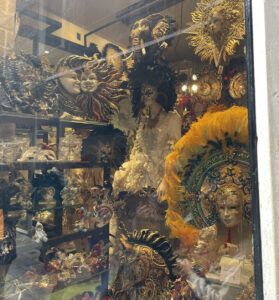
History
The Origins of Venice Italy: Over 1,500 years ago, refugees fleeing barbarian invasions built homes on wooden pilings driven into the marshy Venetian Lagoon. These wooden pilings were topped with stone foundations, forming the base for Venice’s palaces, churches, and public squares. Venice’s strategic location and naval strength allowed it to expand and defend against powers like the Byzantine Empire, Genoa, and the Ottoman Empire. The city’s man-made islands grew into a powerful maritime republic that dominated trade between Europe and the East. This prosperity led Venice into a golden age of art and architecture, with renowned artists like Titian, Tintoretto, and Giovanni Bellini flourishing.
Government and Influence: The Venetian Republic was led by elected officials known as the Doge, akin to a Head of State. His authority was balanced by various institutions, including the Council of Ten, the Senate, and the Great Council. This system of elected representatives bears similarities to the U.S. system of the President and Congress. It is believed that the founders of the United States may have drawn inspiration from the republican principles and government structures of Venice.
Decline and Fall: Over time, Venice’s independence waned due to economic decline and military conflicts. In 1797, Napoleon Bonaparte’s forces conquered Venice, ending over a millennium of independent rule. Afterward, northern Italy, including Venice, fell under Austrian control. It wasn’t until 1866, during the Italian unification movement, that Venice was liberated from Austrian rule and became part of the Kingdom of Italy, led by its first king, Victor Emmanuel II.
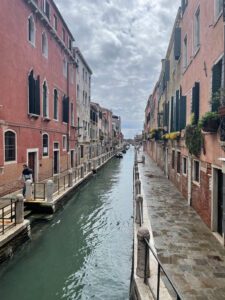
Things to See
The Grand Canal: Venice’s main waterway, the Grand Canal, is a must-see. A gondola ride along this canal is essential to experience Venice’s charm. For stunning views, visit the Rialto Bridge, which connects the San Marco and San Polo districts. It’s one of only four bridges spanning the Grand Canal and offers great photo opportunities and a chance to explore specialty shops along the canal.
St. Mark’s Basilica: Located in St. Mark’s Square, St. Mark’s Basilica is adorned with intricate mosaics, marble columns, and domes. It symbolizes Venice’s wealth and power during the Byzantine era.
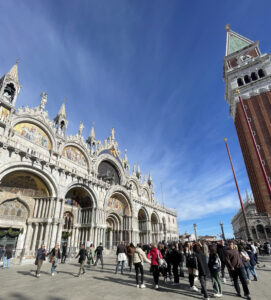
St. Mark’s Square: Piazza San Marco is Venice’s central square, surrounded by landmarks like St. Mark’s Basilica, the Doge’s Palace, and the Campanile (bell tower). You’ll find Caffè Florian here, the world’s oldest continuously operating café, established in 1720. Although pricey, their rich Italian hot chocolate is a must-try, especially on a chilly day.
Doge’s Palace: Adjacent to St. Mark’s Basilica, the Doge’s Palace served as the residence of Venice’s rulers. Explore its grand halls, ornate chambers, and historic artworks by Tintoretto and Veronese. We spent hours admiring the intricately decorated ceilings and listening to the museum’s audio guide—it felt like stepping back in time.
Bridge of Sighs: Connecting the Doge’s Palace to the New Prison, the Bridge of Sighs is a renowned landmark. Tradition holds that prisoners sighed as they crossed this bridge, taking their last glimpse of Venice before imprisonment.
Palazzo Contarini del Bovolo: Known for its distinctive spiral staircase, the Palazzo Contarini del Bovolo was built in the late 15th century by the affluent Contarini family. Designed by Giovanni Candi, it was intended to showcase their wealth and cultural sophistication.
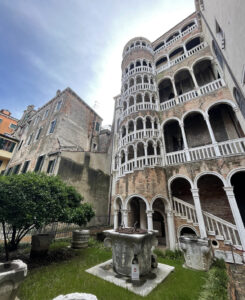
Venetian Cuisine
Venetian cuisine is renowned for its seafood and risottos. A standout dish is risotto al nero di seppia, which features a striking black color from squid ink. Another regional favorite is cicchetti, small plates similar to tapas. These include crostini with creamy spreads, skewered meats and vegetables, and fried treats like arancini (rice balls) or polpette (meatballs).
Recommended Restaurants
Some of the best Italian meals I’ve enjoyed were in Venice. Here are a few recommendations:
-
Trattoria Da GiGio: We stumbled upon this place last minute and were delighted by the delicious, decadent pasta dishes and friendly service.
-
Ca Dolfin: After making reservations, we found this restaurant’s menu to be small but worth it for the freshest frittura di pesce (fried shrimp and calamari) I’ve ever had.
-
Osteria Fanal del Codega: I visited this spot with my mom for lunch, and despite my usual preference for cream sauces, their red sauce was the most flavorful I’ve ever tasted.
-
Farini: For a quick bite, Farini offers pizza by the slice. The pizza is always fresh and delicious, making it a great option for a casual meal.
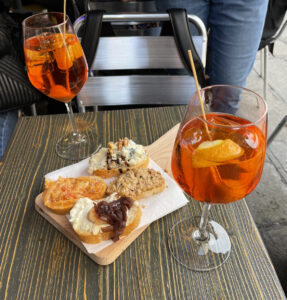
Why are Gondola Rides so expensive?
Venice Italy has a limited number of licensed gondolas, leading to high demand for rides. Traditionally, the gondolier profession is passed down through families, with skills and knowledge shared from father to son. Gondola rides are regulated by the city of Venice, and gondoliers must pay various licensing fees and taxes. Additionally, gondolas are expensive to purchase because they are handcrafted by skilled artisans.
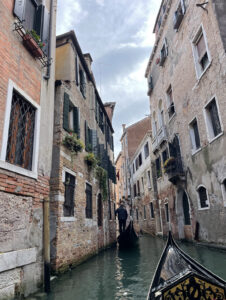
What to buy?
Masks, glass products, and lace are iconic to Venice, with many small shops throughout the city showcasing these crafts. However, I particularly love Venice’s jewelry boutiques. One inexpensive standout is The M Venezia. With several locations on the main island, I was drawn to their store windows each time I passed by. The M Venezia offers customizable jewelry and beautiful Murano glass bead pieces.
Marco Polo and Venice
Marco Polo was born in Venice Italy in 1254 into a wealthy merchant family. His father and uncle, successful traders, ran a lucrative business along the Silk Road. At just 17, Marco joined his father and uncle on their journey to Asia. There, he impressed Kublai Khan, the Mongol ruler of China, with his intelligence and multilingual skills. Appointed as an official in the Khan’s court, Marco spent 24 years traveling across Asia as a diplomat and explorer for the Mongol Empire. His travels took him to Persia, India, Tibet, and Southeast Asia.
Returning to Venice Italy in 1295, Marco Polo found the city at war with Genoa and was captured. While imprisoned, he met Rustichello da Pisa, a writer. Together, they wrote Marco Polo’s memoirs, documenting his incredible adventures in Asia. Their book, The Travels of Marco Polo, became one of the most influential travelogues of the Middle Ages, sparking Europe’s fascination with the East and playing a key role in the Age of Exploration. Marco Polo is celebrated as one of history’s greatest adventurers.
*The popular pool game “Marco Polo” has an unknown origin, but one theory suggests that its call-and-response pattern was inspired by the way travelers in unfamiliar territories would call out to locate each other.
In Summary
Venice is truly unique and remains my favorite city in Italy. With no cars, visitors must explore on foot, navigate the maze of canals by boat, and enjoy some of the best seafood and pasta dishes you’ll ever taste.
I lived in Italy for about a year and a half, so for more Italy travel recommendations, checkout my other posts:
